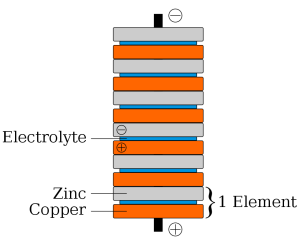How would you like to use a battery that never needs recharging and lasts over 100 years? Sounds too good to be true, but this technology exists and is ancient. It is called a Zamboni Pile (also called a Duluc Pile) and is a very old electrostatic battery first made in the 1800s. It was an improvement over the Voltaic Pile created by Volta in 1799. Volta discovered that two metals (he used copper and zinc) separated by cardboard (or brine solution) generated a potential difference (or voltage). Zamboni used silver and zinc to improve the design. An electrolyte can be used, but even paper or cardboard works because ambient humidity always exists.
The Zamboni pile can be non-toxic, completely recyclable, and can be made to generate any voltage that is needed but at a low current. That’s why these batteries were typically made to create hundreds or even thousands of Volts at low currents to obtain appreciable power.
So how does it work? Simple. It is constructed of silver and zinc foil discs separated by paper (Figure 1). The paper can have silver and zinc pasted deposited on its surface as an alternative. Honey can be used to bond layers. Imagine a battery you can snack on.

Figure 1 – Volta discovered copper and zinc discs separated by an electrolyte or cardboard spacer induce electrostatic charge.
As an electrostatic battery, it does not depend on chemical reactions. Each layer generates about 0.8 Volts from ambient static electricity at low currents, typically nano Amperes. By stacking thousands of layers and compressing them in a glass tube with conductive end caps, Kilo Volt range potentials can be created that last virtually forever. They can be paralleled to produce higher levels of current. The Oxford Bell in the Clarendon Laboratory at the University of Oxford has been continuously ringing for 175 years after it was constructed and is still going strong.
Electrical engineers used to be very comfortable designing high-voltage power supplies and circuits. Before modern low-voltage semiconductor-based electronics, tubes were the way to rectify, amplify, and control power. Tubes use high voltage, typically in the hundreds of volts.
Engineers had to be careful and aware of high-voltage nodes and charged capacitors.
While high voltage may seem a drag, modern semiconductor technology can easily handle high voltage as inputs to very efficient switching regulators. Most computers and equipment no longer require a 120 vs. 220 volts AC switch. The information can typically handle 70 to 250 volt supply voltages and maintain good efficiencies. Switching regulator techniques can also be used for Kilo Volt range step-down regulators.
So, the move to high voltage supplies for electronics designs is not that far fetched as long as you can deal with some of the downsides of the Zamboni Pile. The biggest downside is size. The Zamboni Pile is more significant than conventional batteries and lacks current energy densities. But that is OK for many applications.
Remote sensors distributed in the environment can easily handle larger-size batteries. The payback of not having to send out service technicians every few years to replace batteries and clean solar cells may make this technology feasible and desirable. This technology can benefit even buried sensors in homes, apartments, and buildings. Imagine a smoke detector that never needs battery replacements.
The same is true for the massive number of highway sensors used to monitor biological threats, radiation threats, transponders with EZ Pass, cell phones, RFID for surveillance, and even weather monitoring. Steadily charging a meaty capacitor until it has enough energy to burst to transmit a message wirelessly can be accomplished using high voltage and low current.
There are alternatives to dirty and costly batteries for some applications requiring extended life. It’s nice to have options, and the Zamboni Pile is one of those obscure technologies that have a place in the world today.


The volta battery is not electrostatic, it is based on electric currents of electrons between metals.